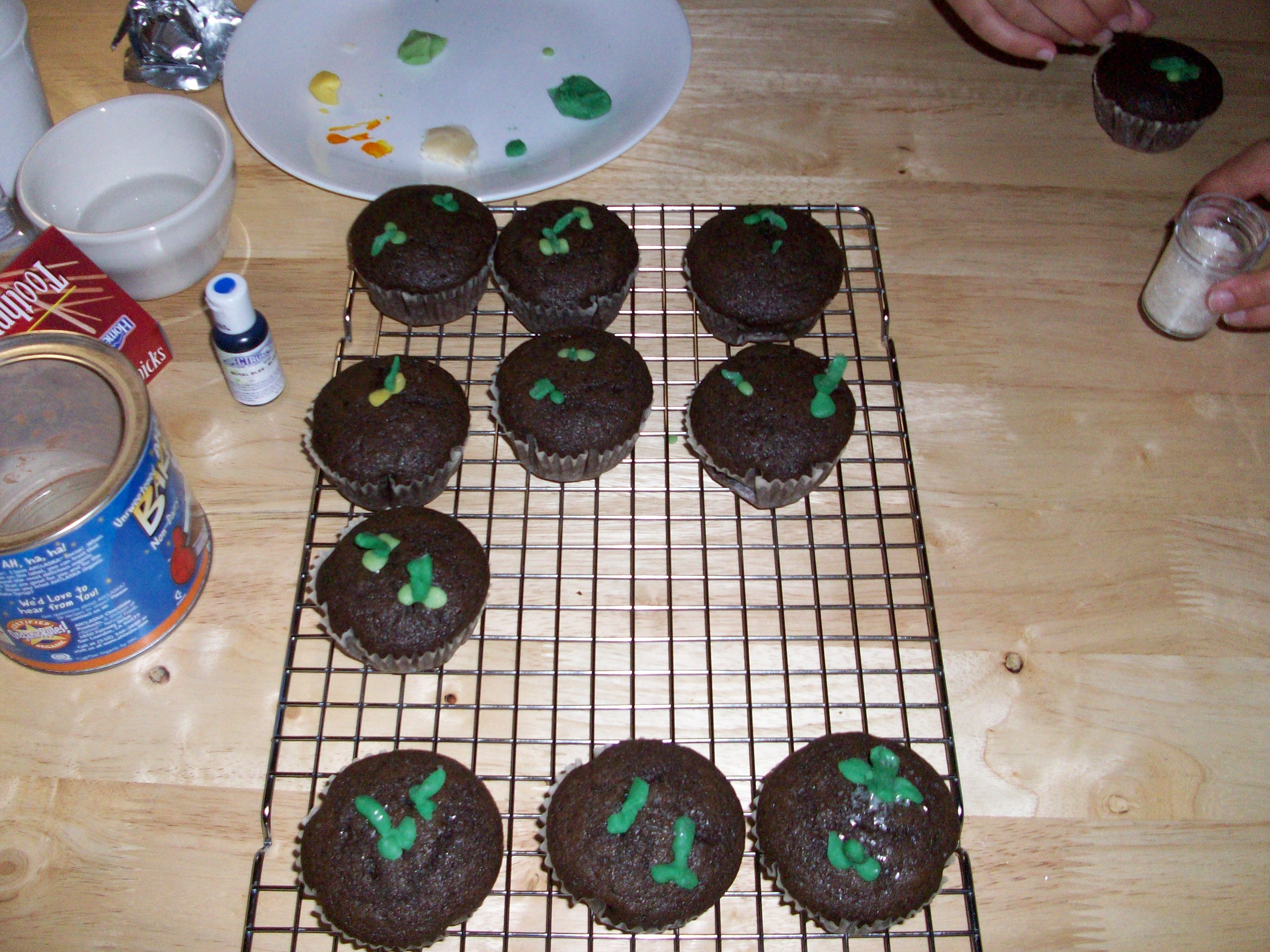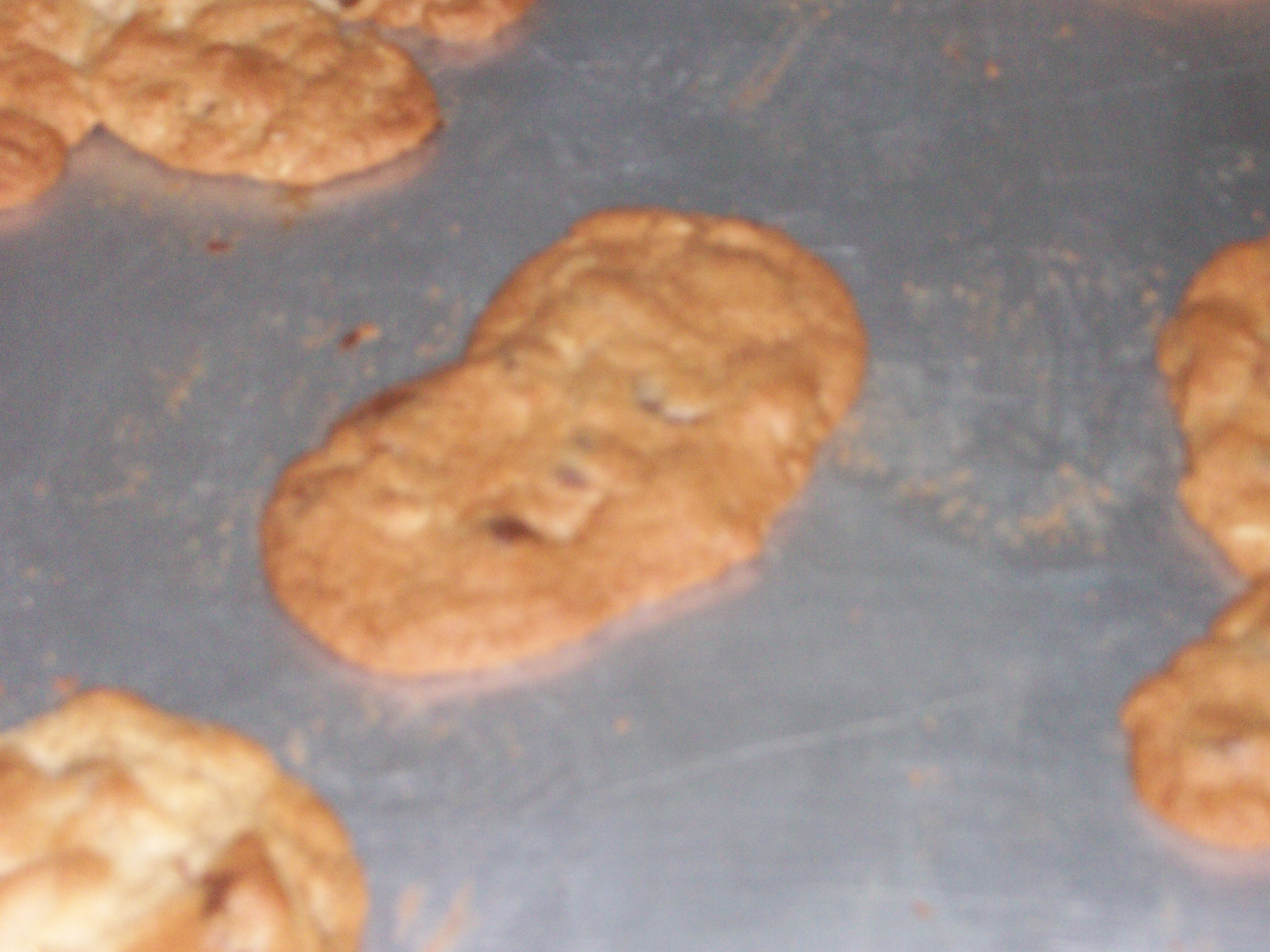|
|
This summer, a very large portion of our lives has been devoted to that Purple Coneflower, Echinacea. This plant has infused itself into our conversations, dreams, birthday cards (my little sister has one coming with a bee and a purple flower,) and yes, baking.
Can you guess what these are?

Seedling cupcakes with vegan chocolate earth, marzipan greens, and sprinkles for the pubescence. Megan’s idea.
What about this?

Why, that is an Echinacea leaf chocolate chip cookie, of course.
Even if we cannot eat the Echinacea, at least it inspires us to bake delicious desserts :).
Project pollinator competition is going well, although it has had its issues, mostly involving my camera/pole/counterweight apparatus. I have chosen my plants and four sites, all roadside: Nessman, Railroad Cross, East Elk Lake Road, and Northwest of Landfill. I am surveying plants that have flowered synchronously except for Nessman where I can survey the entire population. In total, I will record data for about 26 plants and 33 heads.
It was very difficult to get my camera high enough to get a 3 m radius around the plants. Hence, I will be taking multiple pictures of each plant to try to get the distances from the potential competitors to the Echinacea. I’ve done some test shots in the field, and using 1m white “x”s made previously by the kite team has helped a lot to orient myself in the photos and to see how many pixels (not “pickles” like I said to a friend on the phone) are in a meter in each picture. I shot pictures for one of my study plants at Railroad Crossing and also took field measurements for distances from one plant to the other. I repeated the measurements with ImageJ and found that there is only a 2-6% difference in the methods, so I can use them interchangeably! I’m super pumped! This makes much more sense for sites that have few surrounding plants.

A couple plants at East Elk Lake Road. Each of the Xs are uniquely marked, and the cardboard next to the plant is its tag number.
Today, Lecia and I went out to take field measurements. We measured the distances to each potential competitor and the number of florets on those competitors. We used this method for all of the plants at East Elk Lake Road and Railroad Crossing because the competitors are not as dense. But not to worry, for Nessman and Northwest of Landfill I will use the aerial photography. I counted style persistence on all of my plants except for Nessman, which Ben and I did two days ago. Neither are ready for the cameras yet, since some of the Nessman plants have yet to flower and the NWL plants are only on their second day.
Stuart asked for a timeline:
Tuesday (Jul 22nd): Morning or afternoon: take someone who can drive stick with me to nessman and nwlf to take photos, also take style persistence data at all four sites.
Wednesday(Jul 23rd): Morning or afternoon: If we don’t get all of the photos that we need, I want to go out the next day to make sure that all of my measurements are available on the photos.
Friday (July 25th): I need an hour or two myself to take style persistence data.
Monday (July 28th): Also style persistence data (1-2 hours alone)
Thursday (July 31st): more style persistence
Monday (Aug 4th): style persistence
etc. until all of the Nessman plants are done flowering. I can analyze data/pictures on rainy days and on my own time.
Thats the plan!
For my independent research project, I want to assess if plants in homogeneous Echinacea populations fare better with pollinators than plants in populations mixed with introduced sweet clover, introduced thistle, and native prairie rose. To accomplish this, I will apply several methods. First, I will randomly choose flowering Echinacea plants in several of the remnant populations to study. Then, I will record the number of introduced potential competitors as well as other native plants within a certain radius of the plant by using aerial photography. To get the camera high enough above the plant, I will stand on a ladder and hold a ~4m pole with the camera on one end and a counterweight (two wooden blocks nailed together) on the other. I will take two rounds of photos for each plant- once before peak flowering and once after. I will be able to determine distances from plant to plant by placing markers at one meter and calculating the number of pixels per meter when I review the photos.

my giant pole and me.
After classifying the surrounding populations to the flowering plant, I will determine the pollination success by observing the styles of the flower. When a flower receives compatible pollen, within 24 hours the style will shrivel, indicating successful pollination. I can count the number of shriveled style rows in each flower head to determine its success as a pollen receiver. I hypothesize that the flowers in closer proximity to other flowering plants will receive less successful pollen visits than Echinacea in more homogeneous populations. Hopefully, I will collect data from more than twenty plants. The plants are finally flowering, so this week I will be choosing my plants of study and start counting styles when they emerge.
So about a week ago, Team Echinacea was counting and mapping tiny little seedlings. I was working with Gretel, and we had found a plant that apparently knew how to reproduce 47 times in one season. Yes, we mapped out 47 seedlings but not before a spray truck came along.
Because of the strong winds, we could not hear and were quite surprised when a large truck spraying chemicals on a nearby farm rode by us, emitting a putrid scent. Not wanting to breathe in chemicals, Stuart and Gretel began to yell at the spraying perpetrator: “Stop! What are you doing?!��?
The driver stopped, and we all moved upwind, away from the chemical mist. Stuart argued some with the driver who was standing close to the sprayers. Eventually, the driver realized that he was losing the argument (you are not supposed to spray people with chemicals) and drove away.
We decided to move to another spot, and on the way we saw a Bobcat (farm machine, not the animal) on fire. A bunch of cows stood around looking confused. Strange afternoon.
Hi, I’m Julie Stutzbach from Pitman, NJ- a small town near Philadelphia in the southern part of the state. Presently, I am a Bio major at Beloit College where I run cross-country. About a month ago, I returned from Ecuador and the Galapagos Islands where I studied Ecology, Evolution, Botany, Conservation, and assisted Luis Vinueza with a research project on algal distributions. Last summer, I worked at Gateway National Recreation Area in Sandy Hook, NJ on a Botany Invasive Species team trying to control some invasive plants in the park such as Mullein, Autumn Olive, and Tree of Heaven. I especially enjoyed the cut and stump method using chainsaws. You can see me sawing down a Tree of Heaven on YouTube: http://youtube.com/watch?v=cAzu5XQLF30. I am especially interested in Ecology, Botany, and Conservation science making the Echinacea team a solid match for me. After graduating, I want to see as much of the world as I can and then continue on to graduate school.
|
|



